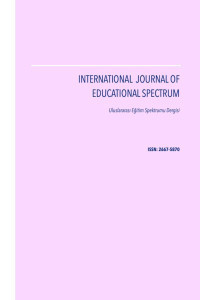Abstract
Teacher attitudes affect student achievement, satisfaction, and self-worth. While accommodations and support networks have long been established for students with exceptional abilities (e.g. gifted-talented students and student athletes), creative students are largely ignored in curriculum and school support. Generally, teachers support creativity in principle, but creative students exhibit characteristics and behaviors largely deemed undesirable, although creative people and students can further studies regarding Csikszentmihalyi’s concepts of flow. The basic question of concern is this: What are teacher attitudes towards creativity and creative students? This literature review attempts to understand teacher attitudes, feelings, perspectives, or emotions regarding creativity, with a call for further research and study.
References
- Csikszentmihalyi, M. (1996, reviewed 2021). The creative personality. Psychology Today. http://www.psychologytoday.com/articles/199607/the-creative-personality.
- Csikszentmihalyi, M. (1990). Flow: The psychology of optimal experience. Harper & Row. https://www.researchgate.net/publication/224927532_Flow_The_Psychology_of_Optimal_Experience.
- Gardiner, P. (2017). Playwriting and flow: The interconnection between creativity, engagement and skill development. International Journal of Education & the Arts, 18(6) (EJ1136728). ERIC. http://www.ijea.org/v18n6/.
- Iowa State University. (n.d.). Informed consent templates. Informed Consent Templates | Office of Research Ethics. Retrieved October 19, 2022, from https://www.compliance.iastate.edu/committees/irb/informed-consent-templates
- Jin, H.-Y., Su, C.-Y. & Chen, C.-H. (2021). Perceptions of teachers regarding the perceived implementation of creative pedagogy in “making” activities. The Journal of Educational Research, 114(1), 29-39. ENMU Golden Library. http://dx.doi.org.glbvvproxy.enmu.edu/10.1080/00220671.2021.1872471.
- Kettler, T, Lamb, K.N., Willerson, A. & Mullet, D.R. (2018). Teachers’ perceptions of creativity in the classroom. Creativity Research Journal, 30(2), 164-171. ENMU Golden Library. http://glbvv001.enmu.edu.glbvvproxy.enmu.edu/login?url=https://search.ebscohost.com/login.aspx?direct=true&AuthType=ip,cookie&db=ehh&AN=129233985&site=eds-live&scope=site.
- Langley, D.W. (2018). Students’ and teachers’ perceptions of creativity in middle and high school choral ensembles. Music Education Research, 20(4), 446-462. ENMU Golden Library. http://glbvv001.enmu.edu/login?url=https://search.ebscohost.com/login.aspx? direct=true&AuthType=ip,cookie&db=ehh&AN=130896361&site=eds-live&scope=site.
- Lee, I, & Park, J. (2021) Student, parent and teacher perceptions on the behavioral characteristics of scientific creativity and the implications to enhance students’ scientific creativity. Journal of Baltic Science Education, 20(1) (EJ1298164). ERIC. https://doi.org/10.33225/jbse/21.20.67
- McCallum, A. (2016). Dangerous and uncontrollable: The politics of creativity in secondary English. English in Education, 50(1). ENMU Golden Library. http://dx.doi.org/10.1111/eie.12098.
- Miyoung, H. & Kang, N.-H. (2009). South Korean and the US secondary school science teachers’ conceptions of creativity and teaching for creativity. International Journal of Science and Mathematics Education, 8(5), 821-843. ENMU Golden Library. http://glbvv001.enmu.edu/login?url=https://search.ebscohost.com/login.aspx?direct=true&AuthType=ip,cookie&db=ehh&AN=53436238&site=eds-live&scope=site.
- Ndeke, G.C.W., Okere, M.I.O. & Keraro, F.N. (2016). Secondary school biology teachers’ perceptions of scientific creativity. Journal of Education and Learning, 5(1). ENMU Golden Library. http://dx.doi.org/10.5539/jel.v5n1p31.
- Shaughnessy, M.F., Brazzolotto, M. & Phelps, C. (2022). Curriculum: Development & education of creativity. Overarching components of creative curriculum concerns [Symposium]. Marconi Institute for Creativity Conference, Bologna, Italy.
- Wilson, A. & Myhill, D.A. (2012). Ways with words: Teachers’ personal epistemologies of the role of metalanguage in the teaching of poetry writing. Language and Education, 26(6), 553-568. ENMU Golden Library. http://dx.doi.org/10.1080/09500782.2012.669768.
- Yuksekyalcin, G., Tanriseven, I. & Sancar-Tokmak, H. (2016). Mathematics and science teachers’ perceptions about using drama during the digital story creation process. Educational Media International, 53(3), 216-227. ENMU Golden Library. http://glbvv001.enmu.edu.glbvvproxy.enmu.edu/login?url=https://search.ebscohost.com/login.aspx?direct=true&AuthType=ip,cookie&db=ehh&AN=119026433&site=eds-live&scope=site.
Abstract
References
- Csikszentmihalyi, M. (1996, reviewed 2021). The creative personality. Psychology Today. http://www.psychologytoday.com/articles/199607/the-creative-personality.
- Csikszentmihalyi, M. (1990). Flow: The psychology of optimal experience. Harper & Row. https://www.researchgate.net/publication/224927532_Flow_The_Psychology_of_Optimal_Experience.
- Gardiner, P. (2017). Playwriting and flow: The interconnection between creativity, engagement and skill development. International Journal of Education & the Arts, 18(6) (EJ1136728). ERIC. http://www.ijea.org/v18n6/.
- Iowa State University. (n.d.). Informed consent templates. Informed Consent Templates | Office of Research Ethics. Retrieved October 19, 2022, from https://www.compliance.iastate.edu/committees/irb/informed-consent-templates
- Jin, H.-Y., Su, C.-Y. & Chen, C.-H. (2021). Perceptions of teachers regarding the perceived implementation of creative pedagogy in “making” activities. The Journal of Educational Research, 114(1), 29-39. ENMU Golden Library. http://dx.doi.org.glbvvproxy.enmu.edu/10.1080/00220671.2021.1872471.
- Kettler, T, Lamb, K.N., Willerson, A. & Mullet, D.R. (2018). Teachers’ perceptions of creativity in the classroom. Creativity Research Journal, 30(2), 164-171. ENMU Golden Library. http://glbvv001.enmu.edu.glbvvproxy.enmu.edu/login?url=https://search.ebscohost.com/login.aspx?direct=true&AuthType=ip,cookie&db=ehh&AN=129233985&site=eds-live&scope=site.
- Langley, D.W. (2018). Students’ and teachers’ perceptions of creativity in middle and high school choral ensembles. Music Education Research, 20(4), 446-462. ENMU Golden Library. http://glbvv001.enmu.edu/login?url=https://search.ebscohost.com/login.aspx? direct=true&AuthType=ip,cookie&db=ehh&AN=130896361&site=eds-live&scope=site.
- Lee, I, & Park, J. (2021) Student, parent and teacher perceptions on the behavioral characteristics of scientific creativity and the implications to enhance students’ scientific creativity. Journal of Baltic Science Education, 20(1) (EJ1298164). ERIC. https://doi.org/10.33225/jbse/21.20.67
- McCallum, A. (2016). Dangerous and uncontrollable: The politics of creativity in secondary English. English in Education, 50(1). ENMU Golden Library. http://dx.doi.org/10.1111/eie.12098.
- Miyoung, H. & Kang, N.-H. (2009). South Korean and the US secondary school science teachers’ conceptions of creativity and teaching for creativity. International Journal of Science and Mathematics Education, 8(5), 821-843. ENMU Golden Library. http://glbvv001.enmu.edu/login?url=https://search.ebscohost.com/login.aspx?direct=true&AuthType=ip,cookie&db=ehh&AN=53436238&site=eds-live&scope=site.
- Ndeke, G.C.W., Okere, M.I.O. & Keraro, F.N. (2016). Secondary school biology teachers’ perceptions of scientific creativity. Journal of Education and Learning, 5(1). ENMU Golden Library. http://dx.doi.org/10.5539/jel.v5n1p31.
- Shaughnessy, M.F., Brazzolotto, M. & Phelps, C. (2022). Curriculum: Development & education of creativity. Overarching components of creative curriculum concerns [Symposium]. Marconi Institute for Creativity Conference, Bologna, Italy.
- Wilson, A. & Myhill, D.A. (2012). Ways with words: Teachers’ personal epistemologies of the role of metalanguage in the teaching of poetry writing. Language and Education, 26(6), 553-568. ENMU Golden Library. http://dx.doi.org/10.1080/09500782.2012.669768.
- Yuksekyalcin, G., Tanriseven, I. & Sancar-Tokmak, H. (2016). Mathematics and science teachers’ perceptions about using drama during the digital story creation process. Educational Media International, 53(3), 216-227. ENMU Golden Library. http://glbvv001.enmu.edu.glbvvproxy.enmu.edu/login?url=https://search.ebscohost.com/login.aspx?direct=true&AuthType=ip,cookie&db=ehh&AN=119026433&site=eds-live&scope=site.
Details
| Primary Language | English |
|---|---|
| Subjects | Other Fields of Education |
| Journal Section | Research Articles |
| Authors | |
| Publication Date | February 28, 2023 |
| Submission Date | January 14, 2023 |
| Published in Issue | Year 2023 Volume: 5 Issue: 1 |
Cited By
The development of an analytical model for science classroom creativity in China
Research in Science & Technological Education
https://doi.org/10.1080/02635143.2024.2377265
.



